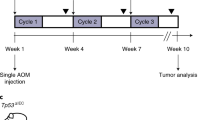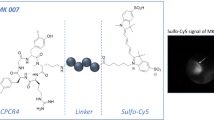Abstract
Advanced stage colorectal cancer (CRC) is still associated with limited prognosis. For preclinical evaluation of novel therapeutic approaches, murine models with orthotopic tumor growth and distant metastases are required. However, these models usually require surgical procedures possibly influencing tumor immunogenicity and development. The aim of this study was to establish a minimal-invasive endoscopy-based murine orthotopic model of metastatic CRC. During colonoscopy of CD-1 nude and non-obese diabetic/severe combined immunodeficiency (NOD/SCID) mice, implantation of Caco-2 and HT-29 CRC cells was performed subcutaneously (s.c.) or orthotopic into the colonic submucosa. White light endoscopy (WLE) and fluorescence endoscopy (FE) were applied for tumor detection in vivo. Ex vivo, resected tumors were examined by fluorescence reflectance imaging (FRI), histology, gelatin zymography and immunohistochemistry. In CD-1 nude mice, marked tumor growth was observed within 14 days after subcutaneous implantation while submucosal implantation failed to induce CRC after 17 weeks. In contrast, in NOD/SCID mice submucosal injection of HT-29 cells resulted in pronounced tumor growth 12 days post injectionem. Subsequently, rapid tumor expansion occurred, occupying the entire colonic circumference. Importantly, post mortem histological analyses confirmed liver metastases in 28.6 % and peritoneal metastases in 14.3 % of all mice. FRI and gelatin zymography did not detect a significantly increased matrix metalloproteinases (MMPs) expression in s.c. implanted tumors while MMP-tracer uptake was significantly enhanced in orthotopic implanted tumors. Neither s.c. nor orthotopic Caco-2 cell implantation resulted in tumor development. We successfully established an endoscopy-based model of metastatic CRC in immunodeficient mice.






Similar content being viewed by others
Abbreviations
- CRC:
-
Colorectal cancer
- MMP:
-
Matrix metalloproteinase
- FRI:
-
Fluorescence reflectance imaging
- FE:
-
Fluorescence endoscopy
- NOD:
-
Non-obese diabetic
- SCID:
-
Severe combined immunodeficiency
- S.C.:
-
Subcutaneous
- NIR:
-
Near infrared
- MMPI:
-
Matrix metalloproteinases inhibitor
- G:
-
Gauge
- HE:
-
Hematoxylin eosin
- IL:
-
Interleukin
- TNF:
-
Tumor necrosis factor
- ROI:
-
Region of interest
References
Torre LA et al (2015) Global cancer statistics, 2012. CA Cancer J Clin 65(2):87–108
Rosenberg DW, Giardina C, Tanaka T (2009) Mouse models for the study of colon carcinogenesis. Carcinogenesis 30(2):183–196
Taketo MM, Edelmann W (2009) Mouse models of colon cancer. Gastroenterology 136(3):780–798
Killion JJ, Radinsky R, Fidler IJ (1998) Orthotopic models are necessary to predict therapy of transplantable tumors in mice. Cancer Metastasis Rev 17(3):279–284
Cespedes MV et al (2007) Orthotopic microinjection of human colon cancer cells in nude mice induces tumor foci in all clinically relevant metastatic sites. Am J Pathol 170(3):1077–1085
Tao L et al (2015) Weichang’an and 5-fluorouracil suppresses colorectal cancer in a mouse model. World J Gastroenterol 21(4):1125–1139
Fu XY et al (1991) Models of human metastatic colon cancer in nude mice orthotopically constructed by using histologically intact patient specimens. Proc Natl Acad Sci USA 88(20):9345–9349
Zigmond E et al (2011) Utilization of murine colonoscopy for orthotopic implantation of colorectal cancer. PLoS One 6(12):e28858
Achyut BR, Yang L (2011) Transforming growth factor-beta in the gastrointestinal and hepatic tumor microenvironment. Gastroenterology 141(4):1167–1178
Suganuma M et al (2012) Human gastric cancer development with TNF-alpha-inducing protein secreted from Helicobacter pylori. Cancer Lett 322(2):133–138
Devaud C et al (2014) Tissues in different anatomical sites can sculpt and vary the tumor microenvironment to affect responses to therapy. Mol Ther 22(1):18–27
Becker C, Fantini MC, Neurath MF (2006) High resolution colonoscopy in live mice. Nat Protoc 1(6):2900–2904
Nakanishi M et al (2007) Utilizing endoscopic technology to reveal real-time proteomic alterations in response to chemoprevention. Proteom Clin Appl 1(12):1660–1666
Heijstek MW, Kranenburg O, Borel IH (2005) Rinkes, mouse models of colorectal cancer and liver metastases. Dig Surg 22(1–2):16–25
Sun FX et al (1999) An ultra-metastatic model of human colon cancer in nude mice. Clin Exp Metastasis 17(1):41–48
Thalheimer A et al (2006) Feasibility and limits of an orthotopic human colon cancer model in nude mice. Comp Med 56(2):105–109
Lennard TW et al (1985) The influence of surgical operations on components of the human immune system. Br J Surg 72(10):771–776
Baxevanis CN et al (1994) Abnormal cytokine serum levels correlate with impaired cellular immune responses after surgery. Clin Immunol Immunopathol 71(1):82–88
Badino GR et al (1996) Evidence for functional beta-adrenoceptor subtypes in CG-5 breast cancer cell. Pharmacol Res 33(4–5):255–260
Marchetti B et al (1991) A potential role for catecholamines in the development and progression of carcinogen-induced mammary tumors: hormonal control of beta-adrenergic receptors and correlation with tumor growth. J Steroid Biochem Mol Biol 38(3):307–320
Moreno-Smith M et al (2011) Dopamine blocks stress-mediated ovarian carcinoma growth. Clin Cancer Res 17(11):3649–3659
Bruckner M et al (2014) Murine endoscopy for in vivo multimodal imaging of carcinogenesis and assessment of intestinal wound healing and inflammation. J Vis Exp 90:e51875–e51875
Schwegmann K et al (2015) Detection of early murine colorectal cancer by MMP-2/-9-guided fluorescence endoscopy. Inflamm Bowel Dis 22(1):82–91
Joshi BP et al (2012) Near-infrared-labeled peptide multimer functions as phage mimic for high affinity, specific targeting of colonic adenomas in vivo (with videos). Gastrointest Endosc 76(6):1197–1206
Liu Z et al (2013) In vivo targeting of colonic dysplasia on fluorescence endoscopy with near-infrared octapeptide. Gut 62(3):395–403
Miller SJ et al (2011) In vivo fluorescence-based endoscopic detection of colon dysplasia in the mouse using a novel peptide probe. PLoS One 6(3):e17384
Schneider CA, Rasband WS, Eliceiri KW (2012) NIH Image to ImageJ: 25 years of image analysis. Nat Methods 9(7):671–675
Bosman FT (2010) WHO classification of tumours of the digestive system. World Health Organization, International Agency for Resarch on Cancer, Lyon
Bettenworth D et al (2011) The tripeptide KdPT protects from intestinal inflammation and maintains intestinal barrier function. Am J Pathol 179(3):1230–1242
Heussen C, Dowdle EB (1980) Electrophoretic analysis of plasminogen activators in polyacrylamide gels containing sodium dodecyl sulfate and copolymerized substrates. Anal Biochem 102(1):196–202
Shultz LD et al (1995) Multiple defects in innate and adaptive immunologic function in NOD/LtSz-scid mice. J Immunol 154(1):180–191
Kim MK et al (2012) Characterization of an oxaliplatin sensitivity predictor in a preclinical murine model of colorectal cancer. Mol Cancer Ther 11(7):1500–1509
Qi J et al (2015) New Wnt/beta-catenin target genes promote experimental metastasis and migration of colorectal cancer cells through different signals. Gut. doi:10.1101/gad.1593107
Bastide C et al (2002) A Nod Scid mouse model to study human prostate cancer. Prostate Cancer Prostatic Dis 5(4):311–315
Hudson WA et al (1998) Xenotransplantation of human lymphoid malignancies is optimized in mice with multiple immunologic defects. Leukemia 12(12):2029–2033
Rygaard J, Povlsen CO (1969) Heterotransplantation of a human malignant tumour to “Nude” mice. Acta Pathol Microbiol Scand 77(4):758–760
Povlsen CO, Rygaard J (1971) Heterotransplantation of human adenocarcinomas of the colon and rectum to the mouse mutant Nude. A study of nine consecutive transplantations. Acta Pathol Microbiol Scand A 79(2):159–169
Giovanella BC, Stehlin JS, Williams LJ Jr (1974) Heterotransplantation of human malignant tumors in “nude” thymusless mice. II. Malignant tumors induced by injection of cell cultures derived from human solid tumors. J Natl Cancer Inst 52(3):921–930
Shimosato Y et al (1976) Transplantation of human tumors in nude mice. J Natl Cancer Inst 56(6):1251–1260
Sharkey FE, Fogh J (1979) Metastasis of human tumors in athymic nude mice. Int J Cancer 24(6):733–738
Shankaran V et al (2001) IFNgamma and lymphocytes prevent primary tumour development and shape tumour immunogenicity. Nature 410(6832):1107–1111
Lee JW et al (2009) Surgical stress promotes tumor growth in ovarian carcinoma. Clin Cancer Res 15(8):2695–2702
Lee JW et al (2013) The effect of surgical wound on ovarian carcinoma growth in an animal model. Anticancer Res 33(8):3177–3184
Neufert C, Becker C, Neurath MF (2007) An inducible mouse model of colon carcinogenesis for the analysis of sporadic and inflammation-driven tumor progression. Nat Protoc 2(8):1998–2004
Tsutsumi S et al (2001) Animal model of para-aortic lymph node metastasis. Cancer Lett 169(1):77–85
Goetz M, Wang TD (2010) Molecular imaging in gastrointestinal endoscopy. Gastroenterology 138(3):828–833
Mitsunaga M et al (2013) Fluorescence endoscopic detection of murine colitis-associated colon cancer by topically applied enzymatically rapid-activatable probe. Gut 62(8):1179–1186
Gounaris E et al (2013) Fluorescence endoscopy of cathepsin activity discriminates dysplasia from colitis. Inflamm Bowel Dis 19(7):1339–1345
Eker C et al (1999) Clinical spectral characterisation of colonic mucosal lesions using autofluorescence and delta aminolevulinic acid sensitisation. Gut 44(4):511–518
Keller R et al (2002) Fluorescence endoscopy using a fluorescein-labeled monoclonal antibody against carcinoembryonic antigen in patients with colorectal carcinoma and adenoma. Endoscopy 34(10):801–807
Egeblad M, Werb Z (2002) New functions for the matrix metalloproteinases in cancer progression. Nat Rev Cancer 2(3):161–174
Hadler-Olsen E, Winberg JO, Uhlin-Hansen L (2013) Matrix metalloproteinases in cancer: their value as diagnostic and prognostic markers and therapeutic targets. Tumour Biol 34(4):2041–2051
Said AH, Raufman JP, Xie G (2014) The role of matrix metalloproteinases in colorectal cancer. Cancers (Basel) 6(1):366–375
Li CY et al (2013) Matrix metalloproteinase 9 expression and prognosis in colorectal cancer: a meta-analysis. Tumour Biol 34(2):735–741
Shi M et al (2013) Matrix metalloproteinase 2 overexpression and prognosis in colorectal cancer: a meta-analysis. Mol Biol Rep 40(1):617–623
Bergers G et al (1999) Effects of angiogenesis inhibitors on multistage carcinogenesis in mice. Science 284(5415):808–812
Boehm T et al (1997) Antiangiogenic therapy of experimental cancer does not induce acquired drug resistance. Nature 390(6658):404–407
McQuibban GA et al (2001) Matrix metalloproteinase activity inactivates the CXC chemokine stromal cell-derived factor-1. J Biol Chem 276(47):43503–43508
McQuibban GA et al (2002) Matrix metalloproteinase processing of monocyte chemoattractant proteins generates CC chemokine receptor antagonists with anti-inflammatory properties in vivo. Blood 100(4):1160–1167
Balkwill F (2004) Cancer and the chemokine network. Nat Rev Cancer 4(7):540–550
McCawley LJ et al (2004) A protective role for matrix metalloproteinase-3 in squamous cell carcinoma. Cancer Res 64(19):6965–6972
Lopez-Otin C, Matrisian LM (2007) Emerging roles of proteases in tumour suppression. Nat Rev Cancer 7(10):800–808
Overall CM, Kleifeld O (2006) Tumour microenvironment—opinion: validating matrix metalloproteinases as drug targets and anti-targets for cancer therapy. Nat Rev Cancer 6(3):227–239
Acknowledgments
We thank S. Dufentester, E. Weber, I. Hoppe, C. Möllmann and D. Reinhardt for their expert technical assistance. This work was supported by an interdisciplinary grant from the Else-Kröner-Fresenius-Stiftung (2012_A94 to PL, DB, DD and MS). P. Lenz was supported by a research fellowship from the Deutsche Forschungsgemeinschaft, collaborative research center SFB 656, Münster, Germany. We thank Faekah Gohar for proofreading the manuscript. D. Bettenworth and P. Lenz were supported by a research fellowship from the Faculty of Medicine, Westfälische Wilhelms-Universität Münster.
Author information
Authors and Affiliations
Corresponding author
Additional information
Dominik Bettenworth and Marcus M. Mücke authors share equal first authorship.
Rights and permissions
About this article
Cite this article
Bettenworth, D., Mücke, M.M., Schwegmann, K. et al. Endoscopy-guided orthotopic implantation of colorectal cancer cells results in metastatic colorectal cancer in mice. Clin Exp Metastasis 33, 551–562 (2016). https://doi.org/10.1007/s10585-016-9797-7
Received:
Accepted:
Published:
Issue Date:
DOI: https://doi.org/10.1007/s10585-016-9797-7




